Biscoff Babka
This Biscoff babka has a rich, tender dough swirled with a biscoff cookie butter filling. It uses a beautiful brioche dough that’s buttery and tender.

Babka is a sweet bread that originated from Eastern European Jewish tradition. It uses a brioche dough. I have a delicious cinnamon babka on the blog and a chocolate chip brioche that uses the same dough. But I’m super excited about this speculoos cookie version. It’s really special.
It tastes like these Biscoff cinnamon rolls but with a more enriched dough. The buttery brioche dough is super tender and rich, swirled with a sweet speculoos cookie butter filling and topped with cookie pieces.
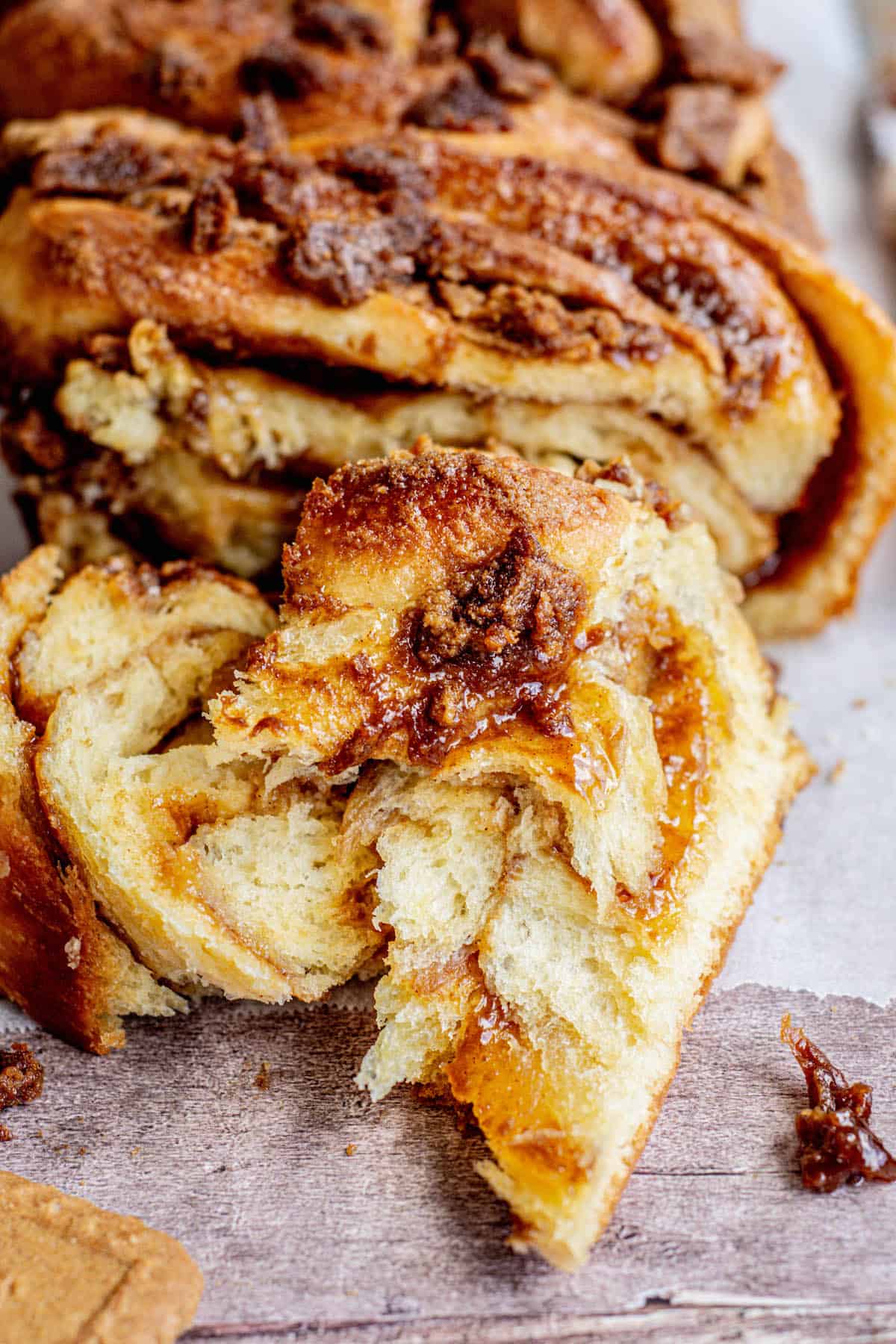
Ingredients
Find the ingredient amounts for this speculoos babka recipe in the printable recipe card at the bottom of this post. Here is a rundown of the dough ingredients.
- All-purpose flour- one with a protein level of around 11%. This protein content is enough to develop the gluten but not too much that the bread is chewy.
- Yeast – Either instant or active dry yeast. Instant yeast will rise faster than active dry yeast. To test the viability of yeast before beginning, warm the milk (to around 95-104°F / 35-40°C) and mix in the yeast with one tablespoon of the sugar. Leave this yeast mixture to sit for 5-10 minutes first. If it becomes foamy, it’s good to go.
- Milk. This can be whole milk or skim milk.
- Large eggs. A large amount of egg in the dough makes it super tender.
- Granulated white sugar.
- Vanilla bean paste or vanilla extract
- Salt.
- Butter – There is plenty of butter needed as it’s an enriched brioche dough. You can use salted or unsalted butter at room temperature.
- Biscoff cookies and cookie butter – This recipe uses Lotus Biscoff speculoos cookies to bring the delicious Biscoff flavor, but the brand doesn’t matter as long as it’s a speculoos cookie butter. If you’re in the US, an alternative brand you can find in grocery stores is Trader Joe’s cookie butter.
- Cinnamon and brown sugar – Along with butter and cookie butter for the babka filling.
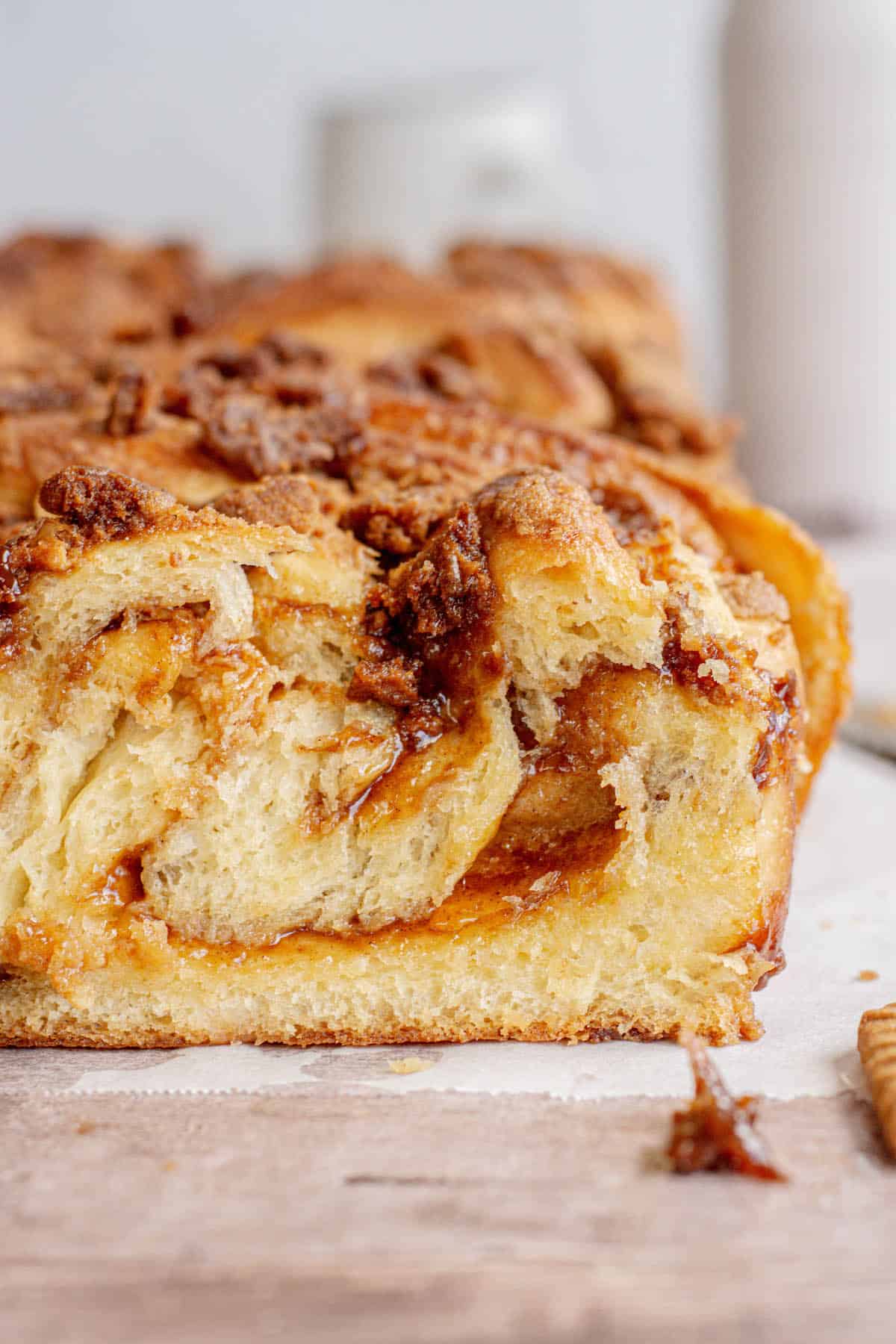
Equipment
- A stand mixer fitted with a dough hook
- Two 9×5 inch loaf pans
Method
Add the warm milk, yeast, and sugar to the bowl of a stand mixer fitted with a dough hook attachment. If using active dry yeast, let this mixture sit for 5-10 minutes until foamy.

Add the eggs, flour, vanilla, and salt to this milk mixture. Mix on slow speed until a thick dough forms.
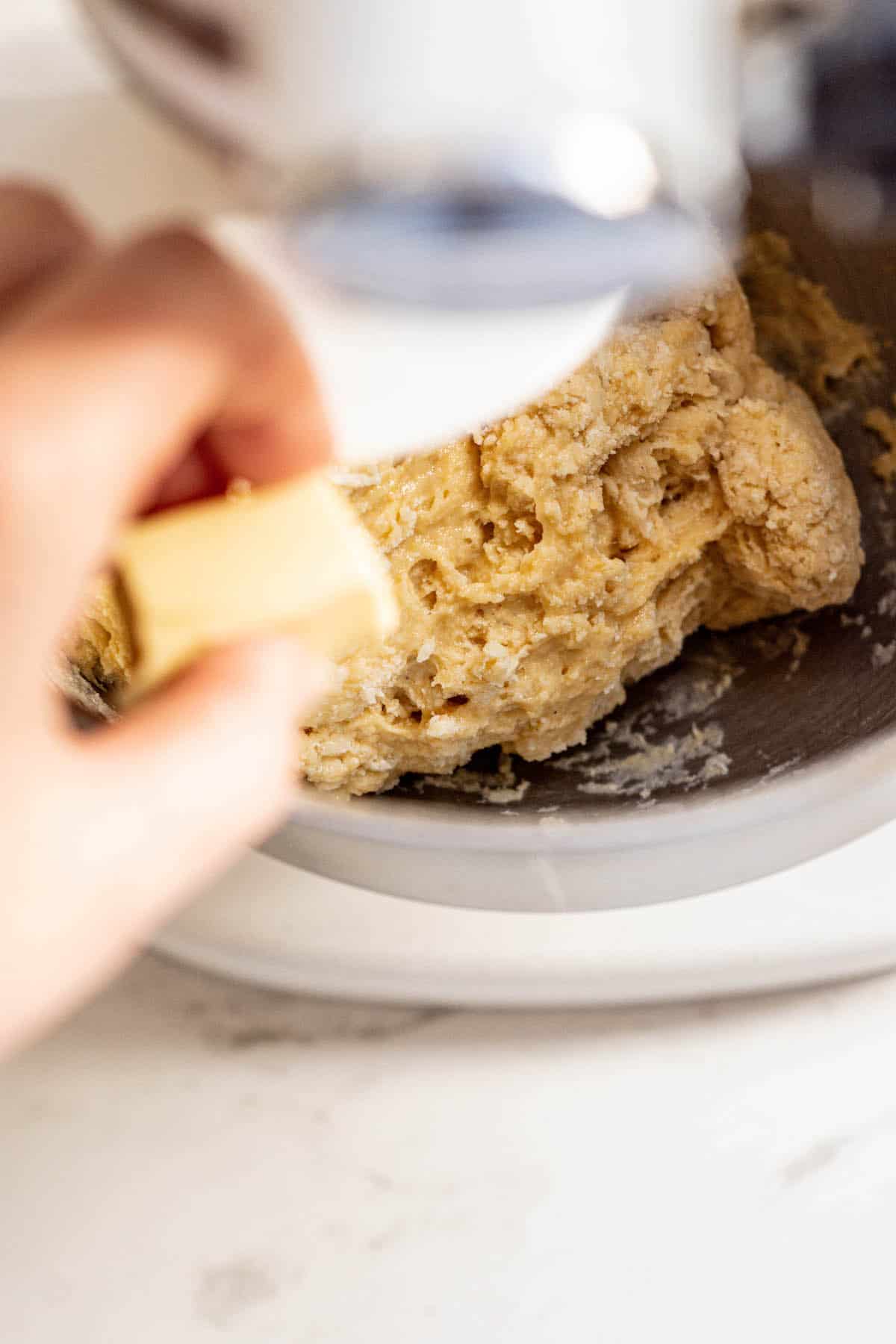
Next, add in the room temperature butter, a few cubes at a time, and keep mixing to incorporate the butter.
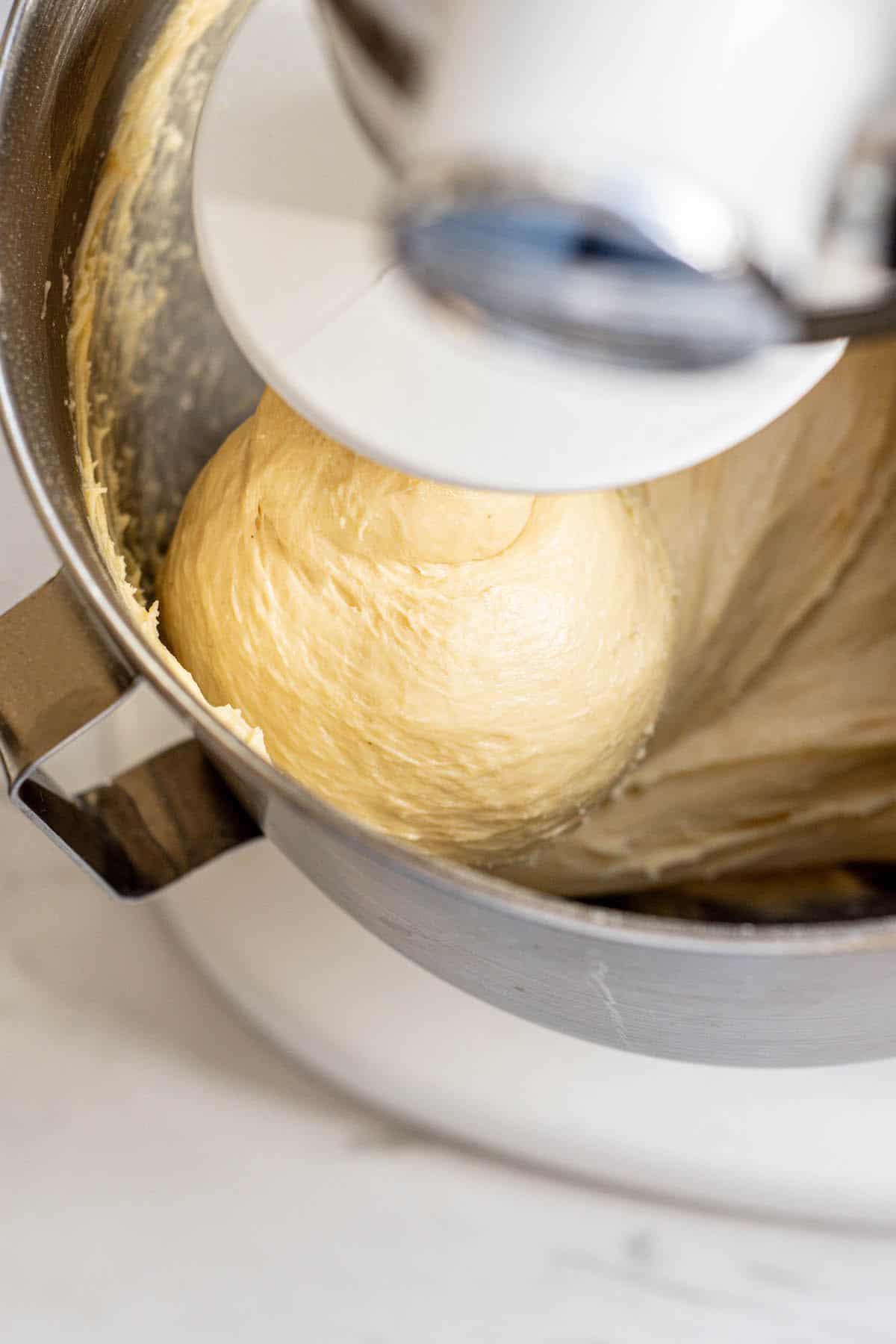
Turn the mixer to medium speed and keep mixing until the sticky dough strengthens and passes the windowpane test. It should pull away cleanly from the sides of the bowl.

Shape the dough into a ball on a lightly floured work surface, then place it into a lightly oiled bowl. Cover the bowl with a lid or plastic wrap and let it proof in a warm place until doubled in size.
Chilling the dough overnight – For more flavor, you can let the dough continue rising in the fridge before shaping it. Let it sit at room temperature for about half an hour first, then cover it well and transfer it to the refrigerator for 8 to 16 hours. The dough will feel stiff when you first take it out and become more pliable as you shape it.
Shaping
Whisk together softened butter, cookie butter, brown sugar, and cinnamon in a medium bowl into a creamy paste.
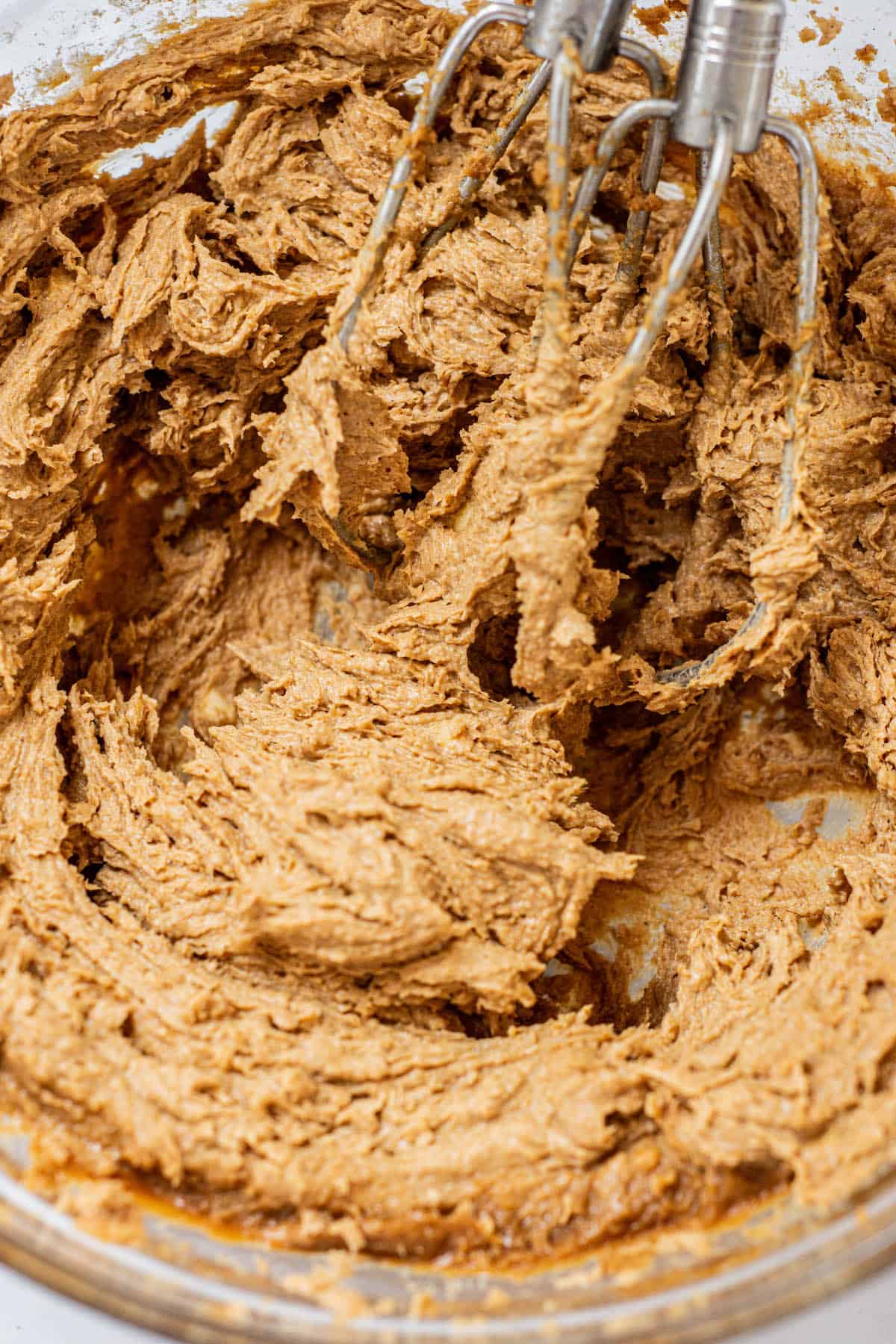
Grease and line two loaf pans with parchment paper.
Deflate the dough and pull it from the bowl onto a lightly floured surface. Weigh the dough on kitchen scales and cut it into two equal pieces.
Take one piece and use a rolling pin to roll it into a rectangle measuring around 11×14 inches (27×35 cm rectangle).
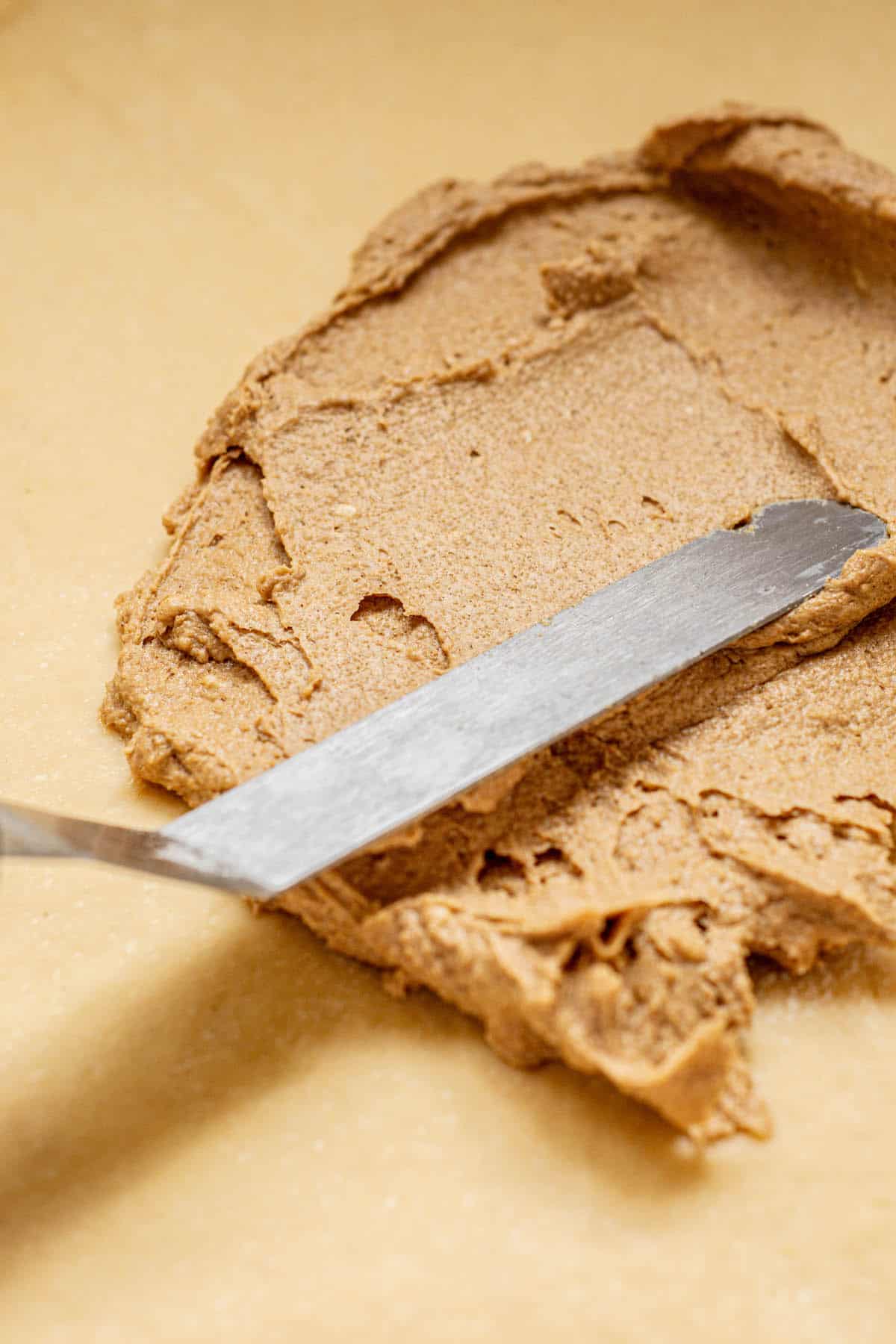
Dollop half the cookie butter mixture over the rectangle in little pieces. Use an offset spatula to spread it out, leaving a ½ inch (1cm) border around all the sides.

Roll it up, from the long edge of the dough into a log, jelly roll style. Place it in the fridge for 15-20 minutes to chill. Repeat with the other dough piece and the remaining filling.
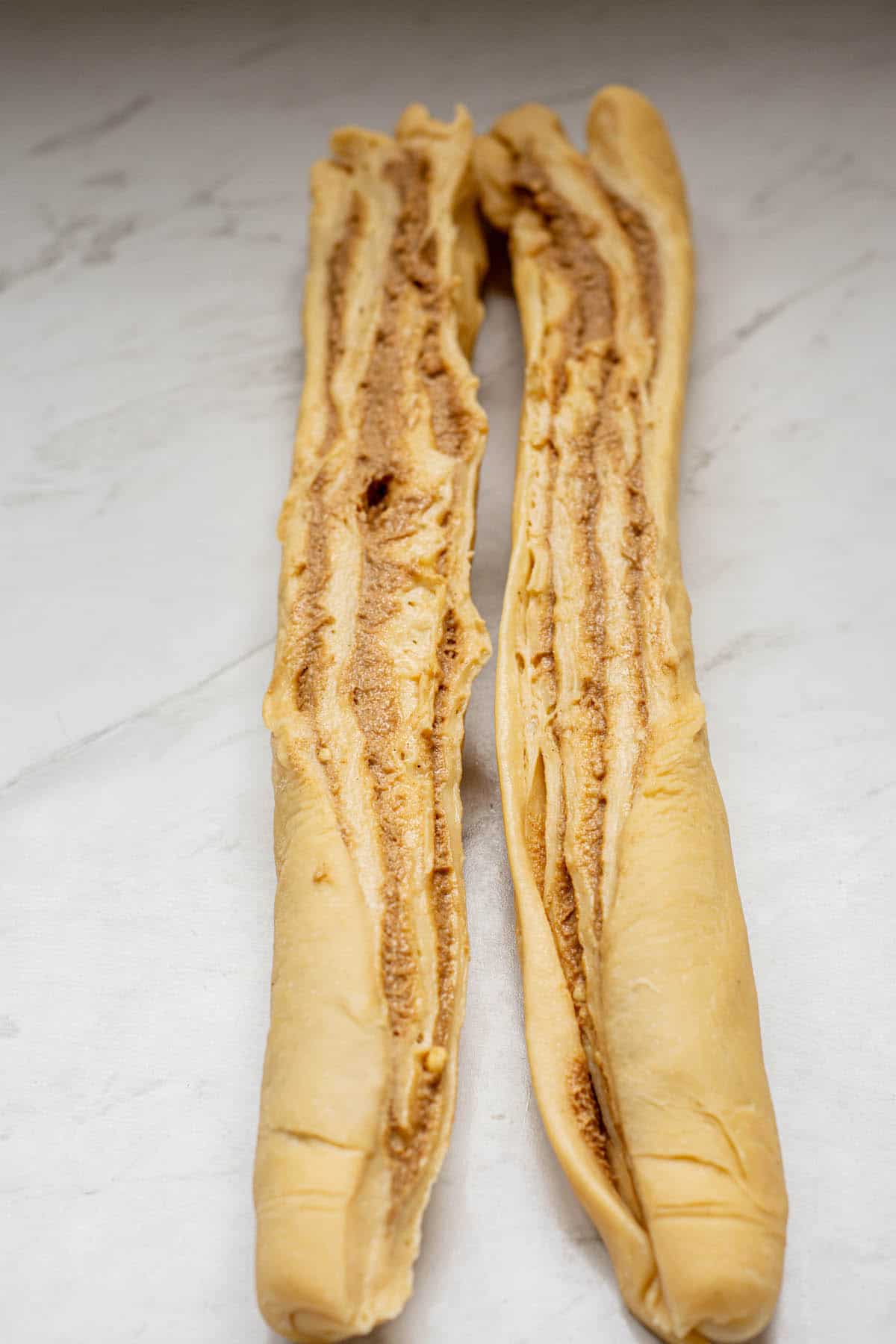
Once chilled, slice a log in half lengthwise with a sharp knife to expose the filling. Take the top two ends and fold them over.
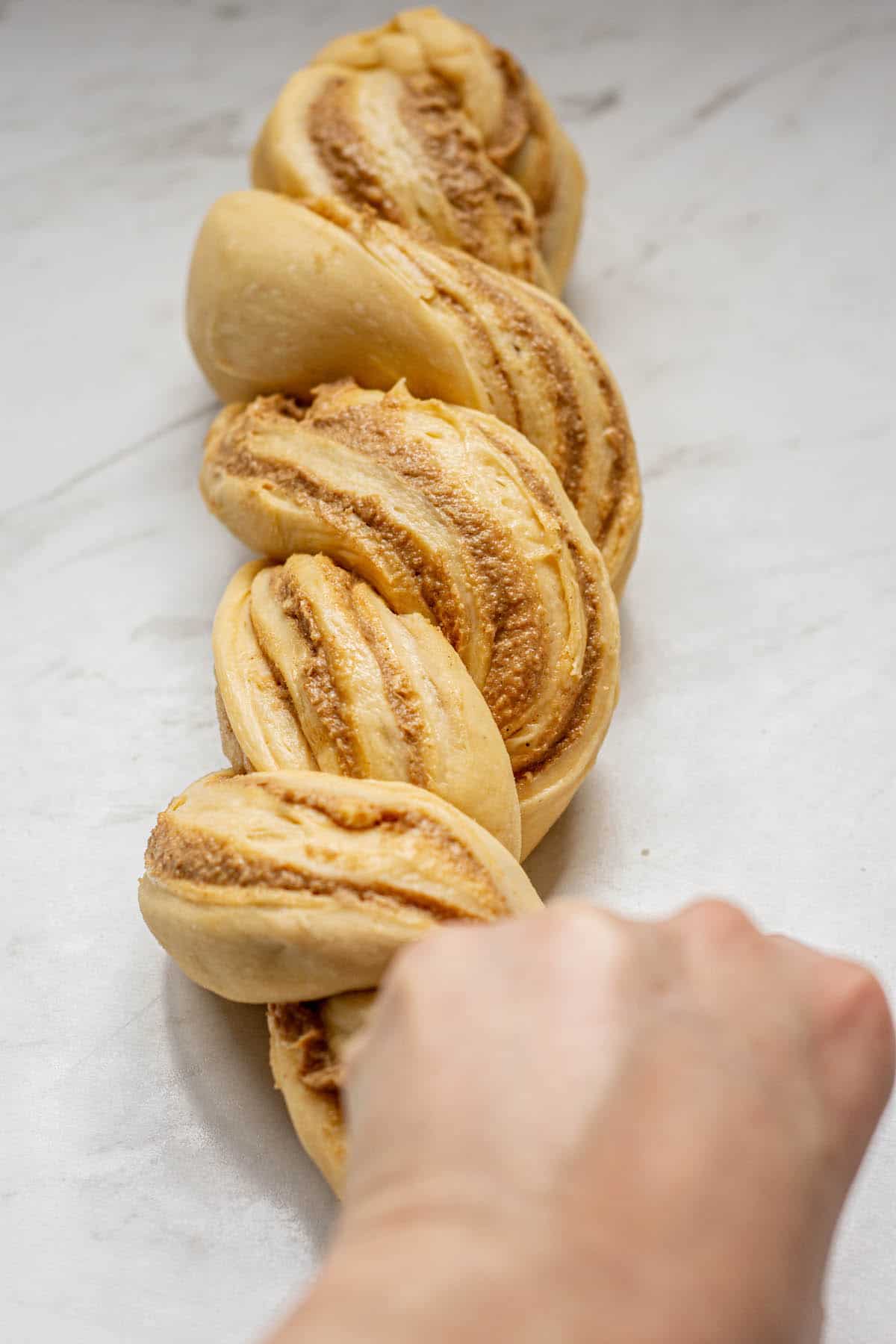
Lift the left half over the right half, then the right over the left, and repeat down, exposing the cut sides and buttery layers of biscoff spread filling.
When you reach the end, tuck the dough underneath to compact the loaf. Place the braid into a prepared loaf pan.
Repeat the process with the second half of the dough.
On top of the twisted loaf, press pieces of broken biscoff biscuits.
Cover and let the babkas undergo a second rise until they nearly double in size, around 1-2 hours. The rising time depends on room temperature.

Baking
Preheat the oven to 350°F/180°C and place a rack in the middle. Bake the risen babkas for approximately 35-40 minutes until deep golden brown. If they are browning too much, loosely cover the tops with foil.
While the babkas are baking, prepare the sugar syrup to glaze them. Combine the sugar and water in a small saucepan over medium heat. Bring it to a simmer until the sugar dissolves, then remove it from the heat.
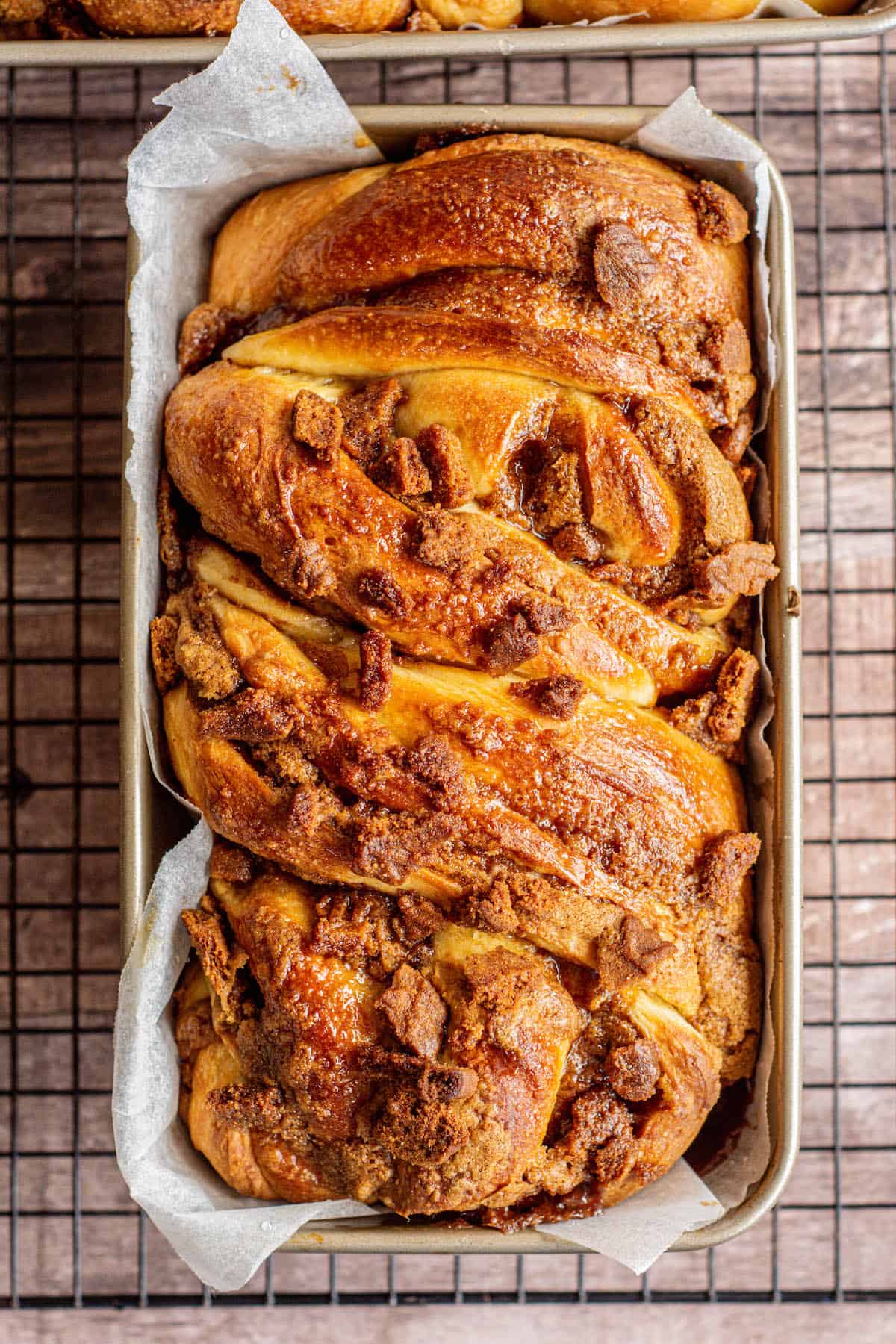

Once the babkas are removed from the oven, brush the top of the babka liberally with the syrup. I avoid getting too much on the pieces of cookie pressed on top so they stay crispy.
Let them cool in their pans for 20 minutes, then remove them and let them cool further on a wire rack. Serve the babka at room temperature or slightly warm. Delicious with a cup of coffee!

Storing
This biscoff babka can be stored in an airtight container at room temperature for up to two days. Alternatively, it can be frozen in a freezer bag for future use. Leftover babka reheats well in the microwave for 5-10 seconds until warm.
Leftover babka makes amazing French toast too!

Biscoff Babka
This Biscoff babka has a rich, tender dough swirled with a biscoff cookie butter filling. It uses a beautiful brioche dough that's buttery and tender.
Ingredients
Ingredients
- 120g (½ cup) milk, lukewarm
- 2 ½ teaspoons instant yeast or active dried yeast
- 50g (¼ cup) granulated sugar
- 500g (4 cups*) all-purpose flour
- 4 large eggs
- 1 teaspoon vanilla paste or extract
- 1 teaspoon salt
- 170g (¾ cup) unsalted butter, at room temperature, cubed
Biscoff filling
- 113g butter, softened to room temperature
- 100g (½ cup) brown sugar, packed
- 2 teaspoons ground cinnamon
- 150g (½ cup) Biscoff cookie butter
Topping
- 4-5 broken biscoff cookies (optional)
- 50g (¼ cup) granulated sugar
- 60g (¼ cup) water
Instructions
- Add the warm milk, yeast, and sugar to the bowl of a stand mixer fitted with a dough hook attachment. If using active dry yeast, let this mixture sit for 5-10 minutes until foamy.
- Add the eggs, flour, vanilla, and salt to this milk mixture. Mix on slow speed until a thick dough forms.
- Next, add in the room temperature butter, a few cubes at a time, and keep mixing to incorporate the butter.
- Turn the mixer to medium speed and keep mixing until the sticky dough strengthens and passes the windowpane test. It should pull away cleanly from the sides of the bowl.
- Shape the dough into a ball on a lightly floured work surface, then place it into a lightly oiled bowl. Cover the bowl with a lid or plastic wrap and let it proof in a warm place until doubled in size.
Filling and Shaping
- Mix softened butter, cookie butter, brown sugar, and cinnamon in a medium bowl with an electric mixer into a creamy paste.
- Grease and line two 9x5 inch loaf pans with parchment paper.
- Deflate the dough and pull it from the bowl onto a lightly floured surface. Weigh the dough on kitchen scales and cut it into two equal pieces.
- Take one piece and use a rolling pin to roll it into a rectangle measuring around 11x14 inches (27x35 cm rectangle).
- Dollop half the cookie butter mixture over the rectangle in little pieces. Use an offset spatula to spread it out, leaving a ½ inch (1cm) border around all the sides.
- Roll it up, from the long edge of the dough into a log, jelly roll style. Place it in the fridge for 15-20 minutes to chill. Repeat with the other dough piece and the remaining filling.
- Once chilled, slice a log in half lengthwise with a sharp knife to expose the filling. Take the top two ends and fold them over. Lift the left half over the right half, then the right over the left, and repeat down, exposing the cut sides and buttery layers of biscoff spread filling. When you reach the end, tuck the dough underneath to compact the loaf.
- Place the braid into a prepared loaf pan. Repeat the process with the second half of the dough. On top of the twisted loaf, press pieces of broken biscoff biscuits.
- Loosely cover and let the babkas undergo a second rise until they nearly double in size, around 1-2 hours. The rising time depends on room temperature.
Baking
- Preheat the oven to 350°F/180°C and place a rack in the middle. Bake the risen babkas for approximately 35-40 minutes until deep golden brown. If they are browning too much, loosely cover the tops with foil.
- While baking the babkas, prepare the sugar syrup to glaze them. Combine the sugar and water in a small saucepan over medium heat. Bring it to a simmer until the sugar dissolves, then remove it from the heat.
- Once the babkas are removed from the oven, brush the top of the babka liberally with the syrup. I avoid getting too much on the pieces of cookie pressed on top so they stay crispy.
- Let them cool in their pans for 20 minutes, then remove them and let them cool further on a wire rack.
Notes
*The cup sizes given are US-sized cups. Note that these are smaller than metric cups. For the best result, use a kitchen scale and grams.
Recommended Products
As an Amazon Associate and member of other affiliate programs, I earn from qualifying purchases.
Nutrition Information:
Yield: 16 Serving Size: 1Amount Per Serving: Calories: 369Total Fat: 20gSaturated Fat: 10gTrans Fat: 0gUnsaturated Fat: 9gCholesterol: 85mgSodium: 227mgCarbohydrates: 42gFiber: 1gSugar: 15gProtein: 6g
This is an informational estimate only. I am not a certified Dietitian or Nutritionist



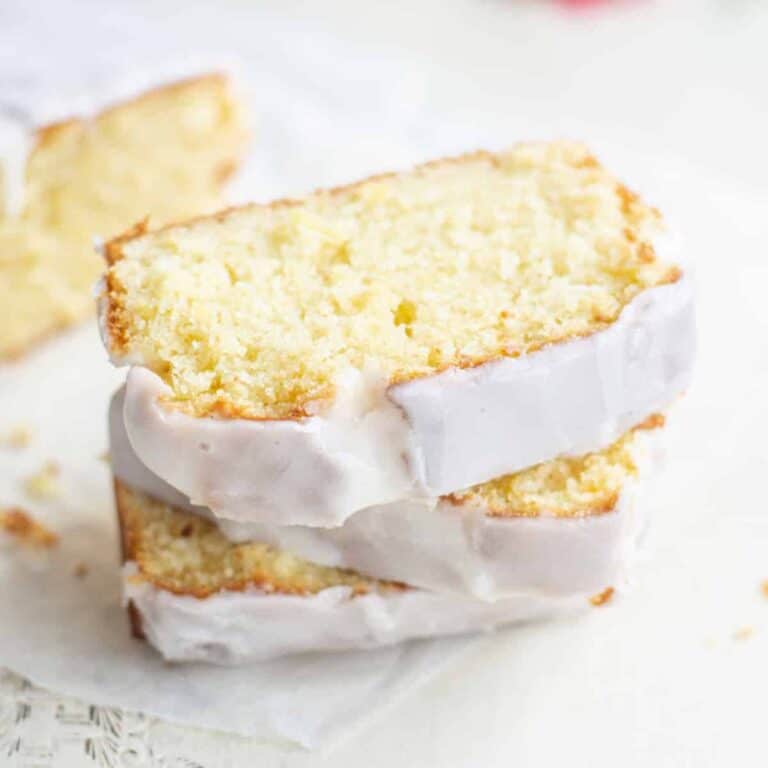
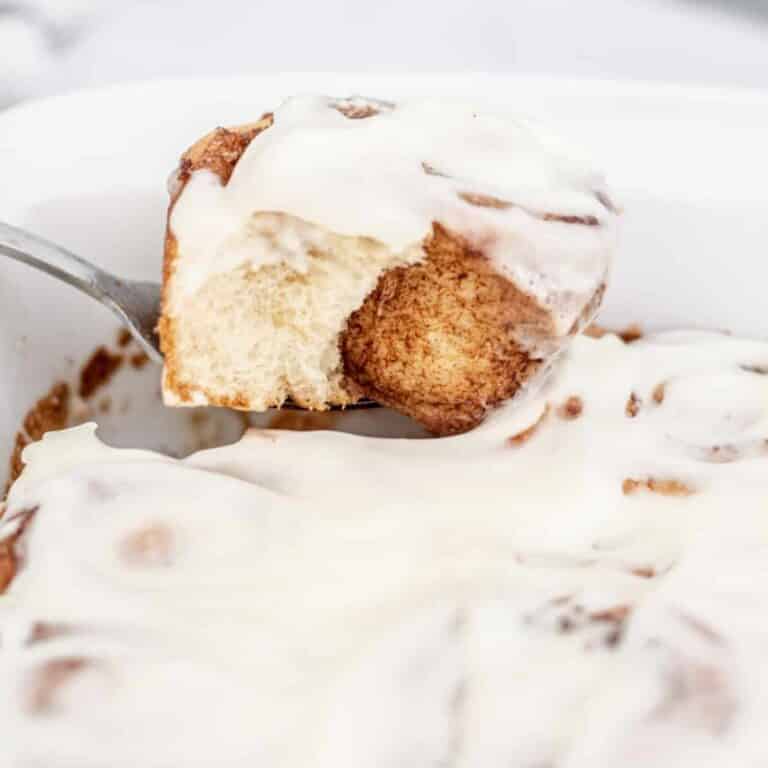

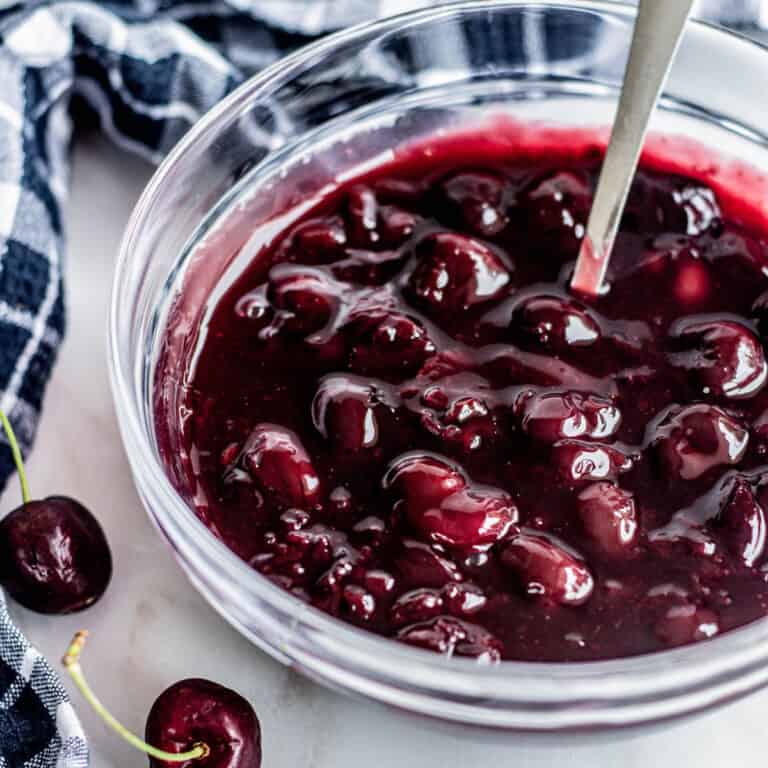
This was fantastic! I doubted it for a moment because I couldn’t get the dough to a point where it came cleanly away from the wall of the mixer bowl even after many minutes. But I scraped it out and continued to great results. Will definitely make again; thank you for a delicous recipe.